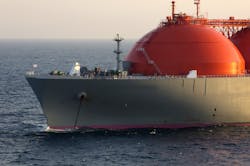Rystad: Northwest Europe gas capacity full as LNG vessels turn into floating storage units
LNG vessels continue to head to Northwest Europe for regasification while gas export pipelines from the region are now at full capacity. The impact is increased waiting time for LNG vessels in the region, with many waiting offshore as floating storages in the meantime, Rystad Energy said in a market note May 23. As a result, spot prices for LNG in Asia are trading higher than Europe.
Already three European countries have been cut off from Russian gas supplies. The latest is Finland, which joined Poland and Bulgaria as Moscow punished the country for its application for join the North Atlantic Treaty Organization (NATO) membership (OGJ Online, May 21, 2022). German authorities have made contingency plans and lists of industries whose supplies will be curtailed if Russia cuts flows. In the interim, however, natural gas is flowing and helping to fill Europe’s storage faster than normal.
The European Union (EU) said last week that countries will not be violating sanctions if they purchase Russian gas, provided that the transaction is completed in euros or dollars, with the Russian Gazprombank performing the conversion to rubles. Considering the transactions will ultimately still be completed in rubles, except on the technicality that countries are not directly paying in rubles themselves, Gazprom is not likely to cut off gas supplies to other European countries, Rystad Energy noted.
Norwegian gas pipeline flows into the UK are expected to be slightly lower due to outages in Norwegian facilities, specifically through Troll field, leading to a rise in UK National Balancing Point (NBP) prices. Meantime, the Dutch Title Transfer Facility (TTF) has gradually fallen recently on the back of steady gas pipeline flows, relatively warmer weather in Europe, and stable wind generation.
However, the NBP at $13.59/MMbtu is still at a discount to the TTF at $25.54/MMbtu. This is largely due to the lack of available slots and berths at regasification ports in Northwest Europe including the UK.
Gas export pipelines to neighboring EU countries are already at maximum capacity, resulting in a glut of natural gas supply within those hubs, creating a large discount of NW-EU LNG delivered prices and gas hub prices such as the NBP and the Spanish Virtual Balancing Point (PVB) to the TTF.
The knock-on effect is increased wait time for LNG carriers with loaded cargo, and many vessels waiting offshore as floating storages. This has reduced the number of vessels available in the market, which has in turn caused charter rates in the Atlantic to increase due to vessels still being busy with previous deliveries, Rystad Energy said.
In Asia, Asia-delivered prices have fallen in the past week tracking the TTF. While demand has not returned in full swing, there has been increased interest in the spot market, resulting in Asia-delivered LNG currently pricing higher than NW-EU delivered prices.
Given that most vessels on the spot market have been plying the Atlantic route to Europe, which is also attracting the bulk of US cargoes, there is a dwindling supply of available vessels due to the increased number of floating storages in Northwest Europe, Rystad concluded.
